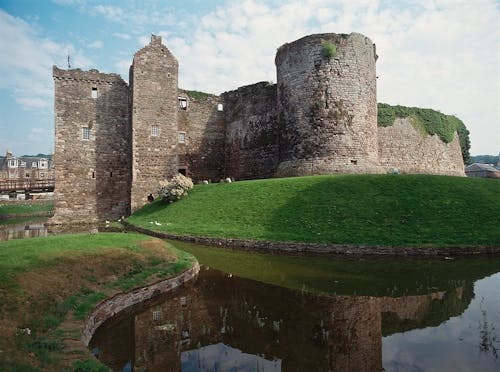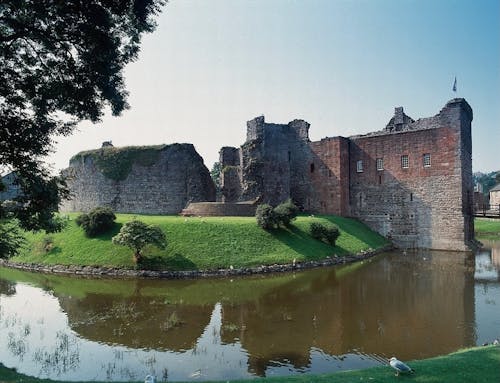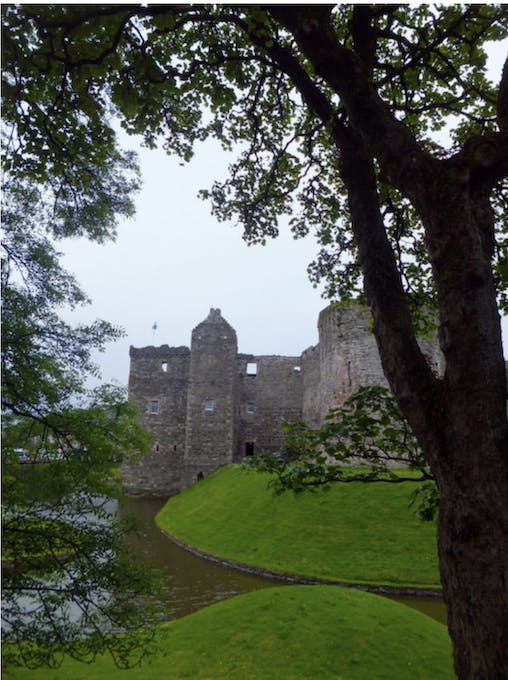
A visit to Rothesay would not be complete without a visiting its medieval centrepiece. Situated at the heart of the island, Rothesay Castle differs from other Scottish castles due to its circular design. It is remarkably well-preserved considering it was originally constructed in the early 1200s and much of what we see today dates back to its initial construction. it has weathered the storms of time and witnessed many battles. Here is a condensed version of its history so far.
*The name Stewart derives from the ancient high office of Steward of Scotland, and would over time evolve into the name Stuart we use today. Originally built by Walter Stewart, 3rd High Steward of Scotland, as a defensive stronghold amid territorial disputes, notably from the marauding Norseman (Vikings). It is thought that the castle was initially constructed in wood, which was later replaced, around 1230, with the circular stone castle and moat – more robust, but I suspect no less draughty. Rothesay Castle was strategically positioned directly on the coast, the sea was further inland in those days and you could probably dip your toes in the water from the battlements! This position took full advantage of Rothesay Bay’s natural harbour.
Things got a bit hairy (literally) in 1230, when the castle faced a fierce siege led by Uspak (or Hácon), the King of the Isles, during which the Norse invaders hacked their way through stone walls with their mighty axes, whilst the castle defenders countered by pouring boiling pitch onto them….it all sounds rather unpleasant! The Norse invaders succeeded in taking the castle, but in doing so King Uspak-Hácon died from the injuries he sustained in battle - being much revered by his men, his body was taken to the sacred Isle of Iona for burial. This victory was short lived, and the Scots rallied and snatched it back, only to lose it again to King Håkon IV. A subsequent battle, the famous Battle of Largs, finally saw off the Norse invaders. It is believed that some of the Scottish warriors who lost their lives during that battle are buried on the nearby Isle of Inchmarnock. The defeat at Largs dashed the Norse aspirations to lay claim to the Western Isles and they eventually surrendered a few years later, thus cementing the Scottish Crown’s dominance in the region. Maidens could sleep soundly in their beds once more.
Recognising the vulnerabilities exposed by these attacks, significant fortifications were added to Rothesay Castle in the late 1200s, including four circular towers and a northern gatehouse. Over the centuries, it served as a residence for Scottish monarchs, notably the House of Stewart, with Robert II (great-grandson of Robert the Bruce) and Robert III spending much of their time there. The local population provided a loyal fighting force for the kings, and local produce was readily available in the form of fish, grain and cattle. It is said that whilst on Bute, Robert III received word that his son, James (future king of Scotland), had been captured by pirates – the shock of which is said to have caused his death in 1406.
Despite its diminished royal role after the death of Robert III, Rothesay Castle remained strategically significant, and was used by King James IV as a military base to control the Western Isles. Under the watchful eye of Ninian Stewart, 6th Sheriff of Bute and Arran, the castle underwent further enhancements, which included the addition of the large residential gatehouse and great hall. It is thought the chapel was also built at this time. This work continued even after King James’s met a grisly end at the Battle of Flodden.
As time marched on, the castle continued to see its fair share of action – it served as a makeshift base for Cromwell’s troops during the Civil War in the 1650s, enduring partial demolition by the troops as they left supposedly to prevent it being used against them in the future.
After a fiery episode during the Argyll Rising in 1685, a failed attempt to overthrow King James II and IV by the Duke of Argyll, the castle was plundered and set alight, thus beginning a slow decline into ruin.
Thankfully some TLC came its way in the 19th and 20th centuries, courtesy of the 2nd and 3rd Marquesses of Bute. The renowned architect, William Burgess, was tasked with the re-construction of the gatehouse and even the re-excavation of the moat. Work was also done which would allow the Great Hall to be used again – finally, the castle had at least some of its former grandeur restored.
Today, under the care of Historic Environment Scotland, Rothesay Castle stands as a testament to Scotland's rich history and architectural heritage, allowing visitors to explore its tumultuous past. Brave visitors can even request access to the castle’s pit prison or dungeon – a window into the past and an opportunity to try to imagine the utter despair of any poor soul unfortunate enough to find him or herself imprisoned there.
But watch out for the “Bloody Stairs’ (and that’s not a personal reference to my feelings about the stairs) ~ legend has it that, following the murder of her family by the invading Vikings, Lady Isobel was to be wed to one of the marauders and rather than face that dreadful fate, she threw herself down the stairs to her death. The castle is said to be haunted by her ghost known as the “Green Lady”
The castle has undergone further renovations over the years, most recently a two year project concluding in March 2024. The castle may not be as large or intact as some of it’s more famous cousins in Edinburgh and Stirling, but it is no less interesting and well worth a visit. It can also be hired for events and weddings, adding a distinctive and quirky charm to any occasion.



